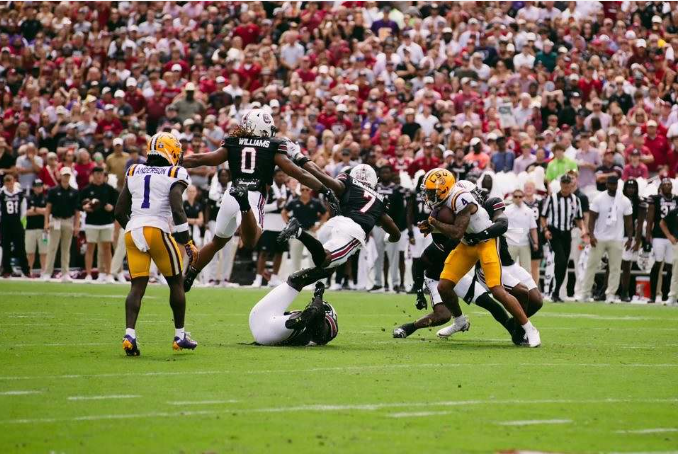
SEC Refs Steal An Upset From South Carolina
Regular members of our audience know I am the last person to make excuses for the University of South Carolina football program. Quite the opposite, in fact. My view is holding people accountable is how you create positive change. Want to keep losing? Keep enabling or accommodating them.
This column is something of a deviation, then… albeit a necessary one in light of the utterly atrocious officiating which cost head coach Shane Beamer’s 2024 team its shot at a second straight SEC upset against No. 16 LSU on Saturday.
A lot of games are lost… but I believe this one was straight up stolen.
Blaming the referees for a loss is obviously old hat at South Carolina, a school which – with a few rare exceptions – has defined mediocrity during its 131 years on the gridiron (and thus, has needed someone to blame). Attending games during the 1980s, I recall fans excoriating officials from the Atlantic Coast Conference for purportedly putting the screws to the Gamecocks – who bolted the conference in 1970.
Since joining the SEC in 1992, South Carolina has posted an anemic 110-149-1 (.425) record in conference play – although the brunt of the blame for that poor showing cannot be placed on the officiating.
Saturday’s loss, though, is another story… sparking calls for an investigation into the officiating, which was actually worse than it was the last time LSU came to Williams-Brice Stadium in 2008.
And in that game, an umpire actually laid out former South Carolina quarterback Stephen Garcia.
No, seriously…
South Carolina was flagged 13 times for 123 yards in its 36-33 loss to the Bayou Bengals on Saturday. That yellow laundry-fest included a pair of costly personal foul penalties against former Georgia Tech defensive end Kyle Kennard that took two defensive touchdowns off the board.
In fairness, the first call – a fifteen-yard horse-collar penalty which negated a 26-yard interception return for a touchdown by senior defensive back O’Donnell Fortune – appears to have been justified.
As you can see on the instant replays of the play, Kennard is clearly grabbing underneath LSU quarterback Garrett Nussmeier’s jersey – and using it to pull him to the ground. Even assuming Kennard grabbed onto the outside of Nussmeier’s jersey as opposed to inside the collar (which he didn’t), it still counts as a horse-collar tackle because the rule was amended in 2017 to include “the area” of a player’s shoulder pads or back of their jersey.
So in this situation, a horse collar penalty would have been called either way…
Wait, though… wasn’t Nussmeier throwing the football from inside the tackle box when Kennard pulled him down? And aren’t passers inside the tackle box able to be brought down using the horse-collar method?
Yes… well, until this season, anyway. Heading into 2024, the NCAA changed its rules again and made horse-collar tackles which “occur within the tackle box” subject to a personal foul flag. And a fifteen-yard penalty.
So, “upon further review,” the first penalty against Kennard probably passes muster. But the second call – which negated a 100-yard interception return for a touchdown by junior safety Nick Emmanwori – was a different story altogether.
Let’s analyze that play a bit closer…
This call – which occurred at a pivotal moment in the game – was pure trash. Not just incorrect, inexcusable.
I’m sorry, but once a quarterback throws an interception he becomes a defensive player… and the last time I checked, defensive players can be blocked. In fact, they’re supposed to be blocked. That’s literally one of the most fundamental job descriptions for a football player: Blocking.
This was not the LSU practice field. There was no red jersey on Nussmeier. This was a live ball. Also, the replays make clear the LSU signal-caller was making a move toward Emmanwori at the time Kennard laid him out – which further justified the hit. And while there was no way Nussmeier was ever going to catch the speedy defensive back running down the sideline, you never know what can happen on a play.
Perhaps an LSU player did catch up to Emmanwori? Or force him to cut back during his return? Perhaps after cutting back, Emmanwori fumbled backward on the play?
All of those are scenarios in which it benefits South Carolina to have the LSU quarterback picking himself up off the turf as opposed to racing downfield following the play. So, taking Nussmeier out of the play wasn’t “unnecessary” – as ESPN announcers Chris Fowler and Kirk Herbstreit erroneously opined – it was smart football.
Also, Kennard’s hit on the LSU quarterback was from the front and at shoulder level – a perfectly legal block.
Don’t want to get laid out? Don’t try and chase the play…
Had Emmanwori’s interception return stood, South Carolina would have been up 40-29 with less than six minutes to go in the game. Beamer would have had his upset – and a potentially season-shifting victory.
Adding insult to injury, the terrible call against Kennard came just six plays after the Gamecocks were flagged for a phantom offensive pass interference penalty against Mazeo Bennett Jr. – a call which nullified a huge, 43-yard completion from backup quarterback Robby Ashford to wide receiver Dalevon Campbell.
Don’t get me wrong: South Carolina became one-dimensional offensively after Ashford was called upon to replace starting quarterback LaNorris Sellers – who injured his ankle on the final play of the first half. And the Gamecocks made plenty of their own mistakes in the second half as LSU battled back from an eight-point halftime deficit.
And in all honesty, maybe I’m just pissed because I predicted the upset (and at least one defensive touchdown)… only to see my football genius invalidated.
Still, there are games teams lose and then there are games teams have taken from them… and this one clearly fell in the latter category.

Leave a Reply